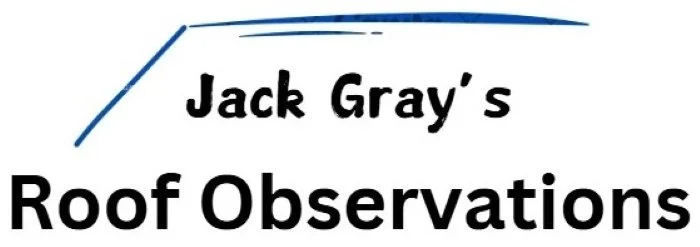I participate in the Amazon affiliate program and may earn commissions from purchases made through links on this page.
Table of Contents
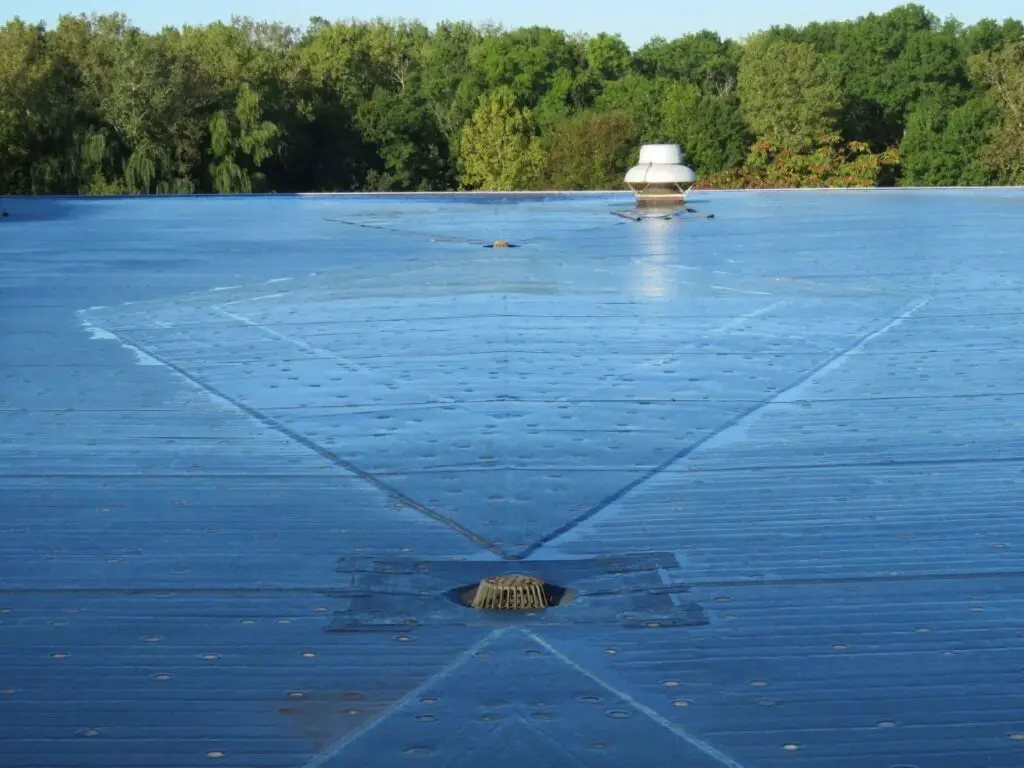
Introduction
EPDM roofing is a type of low-slope (“flat”) roofing system widely used in commercial and industrial construction. EPDM membranes have been in use since the late 1960s, and they now have a long, well-documented track record of performance that spans more than five decades.
After TPO membranes, EPDM membranes are the second-most popular type of single-ply membranes used on commercial buildings. EPDM roofing is also a very common material when it comes to residential flat roofs. My parents have an EPDM roof on their garage.
I’ve been specifying, inspecting, and maintaining EPDM roofing systems for over 20 years. I’ve also spent a lot of time as a quality assurance observer during EPDM roof installations.
(Quality assurance observation means that you stand on the roof during the installation and watch everything that goes on during the job. You make sure that the roofing contractor is installing the material according to best practices, the manufacturer’s recommendations, and the consultant’s specifications for that particular roof.)
I thought I’d share some of what I’ve learned.
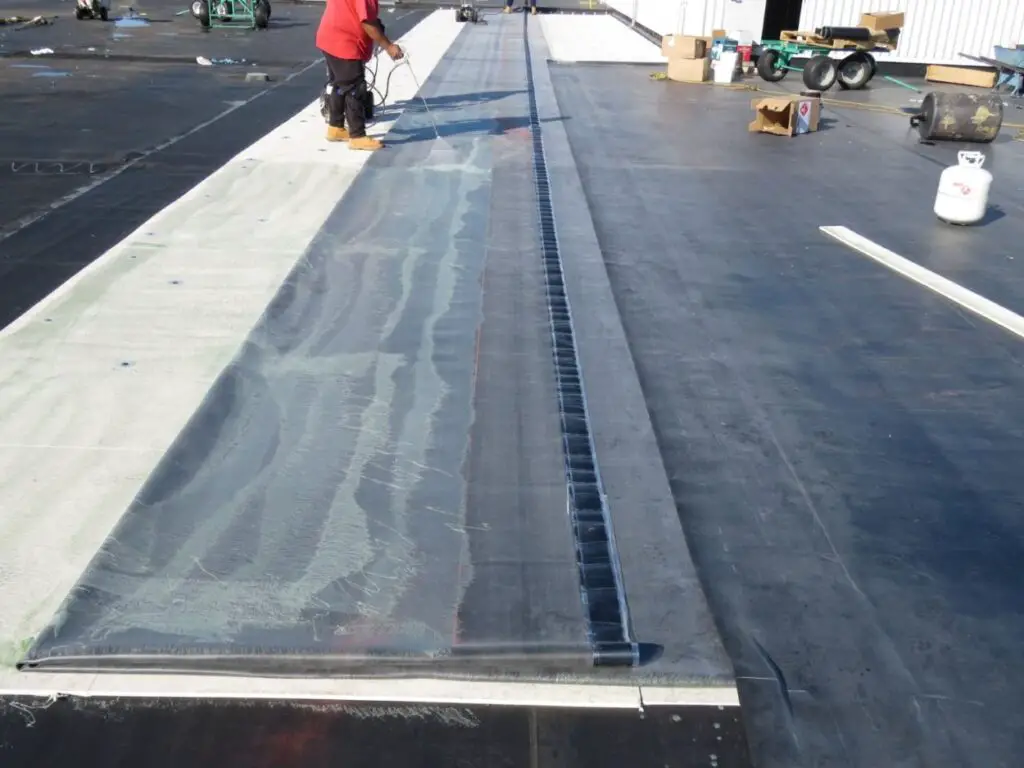
Pros & Cons of EPDM Rubber Roofing
If you’re just skimming this article to get a general sense of the advantages and disadvantages of an EPDM roof, here’s a short overview of the strong points and weak points of EPDM roofing. I get into more depth in the rest of article.
Pros of EPDM Roofing
Long Service Life
EPDM roofing generally lasts significantly longer than TPO, and about the same or longer than a similarly-installed PVC roof. I have personally seen EPDM roofs that lasted for over 50 years before they needed to be replaced. Of course, those roofs were consistently well-maintained and repaired as we recommended. The useful service life for a properly designed and well-maintained EPDM roof is usually in the range of 25–35 years, with 40+ years possible under very favorable conditions. Membrane thickness matters here: roofs with thicker membranes usually last longer.
Lower Material Cost
Except for TPO, which will often be a little cheaper, EPDM roofing will typically cost less than any other low-slope roof system. Ballasted EPDM is the cheapest commercial low-slope roof system there is. The cost of EPDM roofing is commonly considered one of its main benefits. Fully-adhered and mechanically-attached EPDM will cost more than ballasted but are still relatively affordable. The total cost of any low-slope roof system will also depend a lot on the type of insulation and how much is needed to meet local R-value requirements.
Lower Installation Cost
EPDM is an extremely popular commercial roofing material in colder climate zones. It’s easy to get competitive bids for an EPDM roofing installation, and just about every commercial roofing contractor in cooler regions will have roofing crews with plenty of EPDM experience. EPDM is also available in very wide sheets, so large sections can be applied quickly, with fewer seams and less labor as a result.
Lower Repair Costs
Related to its low installation cost is its low repair cost. Unlike PVC and TPO, which can only be properly repaired using hot air heat welding tools (and roofers trained to use them), EPDM can be repaired using pieces of membrane and fairly cheap adhesives. Peel-and-stick EPDM patches make minor repairs so easy that most facility maintenance technicians should be able to do it themselves without calling a roofer. Proper repairs do require cleaning, priming, and pressure rolling (quick “slap-on” patches will fail), but material and tool costs are very modest. Learn how to make simple EPDM repairs.
Recycling
EPDM is one of the only flat roof materials that not only can be recycled, but actually does get recycled. See this page on the EPDM Roofing Association website for more details. Installation scrap and post-consumer tear-off material are both accepted in recycling programs in many places, which helps divert material from landfills.
Cool Roof
White EPDM roof membranes are available and they come with a white reflective surface for energy savings, LEED points, etc. Keep in mind that white EPDM costs more than normal black EPDM and doesn’t typically last as long. It also costs more than regular EPDM. If a high-reflectance “cool roof” is your primary goal, also research TPO and PVC.
Not a Cool Roof
Standard EPDM roof membranes are black. Unlike reflective white TPO or PVC membranes, black EPDM absorbs solar heat and can increase roof surface temperatures and the amount of heat transmitted into the building. In some locations, this is actually desirable, as it may help lower heating costs (rather than lowering cooling costs). So this can be a benefit in cold or mixed climates, on buildings with higher heating demand than cooling demand.
Cons of EPDM Roofing
Relatively Easily Damaged
When compared to the two other main types of single-ply membrane, TPO and PVC, unreinforced EPDM (which is used on the majority of EPDM roofs) is more susceptible to puncture damage from careless foot traffic, dropped tools, etc. Reinforced EPDM is available and improves puncture resistance, and installing walkway pads at service routes helps a lot.
EPDM roofs should always be inspected for puncture damage after any storm where large pieces of wind-blown debris were noted.
EPDM is also easily damaged by petroleum products and kitchen grease. Restaurant kitchen exhaust and leaking or spilled HVAC lubricants are a common cause of EPDM membrane damage. Use compatible sacrificial protection sheets or switch to grease-containment solutions where rooftop discharge cannot be eliminated.
Vulnerable to Ponding Water
Unlike TPO or PVC, where the roofing sheets and flashing pieces are all heat-welded together, EPDM roofing depends on adhesives to hold everything together. These adhesives will deteriorate (very slowly!) when subjected to long-term standing water due to poor roof drainage. Poor drainage and chronic ponding water may take years off the life of an EPDM roof due to premature seam failure. Modern butyl seam tapes are very durable, but chronic ponding can still compromise their performance over time. Ensuring positive roof drainage and/or adding supplemental drains is often a high-ROI fix.
Slippery When Wet
EPDM roof membranes are extremely slippery after it rains. Anyone accessing the roof should be extremely careful when the roof is wet, and should really wait until the roof dries off before walking on it. You should post a “wet conditions” warning at roof access points and require slip-resistant footwear for anyone getting on the roof.
Appearance
A lot of people think EPDM roofs are kind of ugly. Most commercial flat roofs can’t normally be seen, so this isn’t much of a drawback, but you might want to think twice about using it for residential applications. If appearance matters, consider a paver, vegetative, or coating system (approved by the manufacturer).
What is EPDM Roofing?
EPDM is a durable, waterproof, elastomeric, and highly flexible synthetic rubber which is well-suited for use as a single-ply roofing material for many reasons. “EPDM” is an acronym for “ethylene propylene diene monomer”, which is the full chemical name of EPDM rubber. In roofing, EPDM is manufactured as large vulcanized sheets (rolls) in common thicknesses like 45-mil, 60-mil, and 90-mil; most membranes are black, with white EPDM available for reflective applications.
“EPDM roofing” refers to single-ply low-slope roof systems where sheets of EPDM rubber are joined together to make a waterproof roof membrane. Seams and flashings are formed using primers, seam tapes, and adhesives rather than heat welding (which is used with TPO and PVC).
When people talk about “rubber” roofs, they are pretty much always talking about EPDM. EPDM is the primary true rubber roofing material used to construct entire roof membranes. Other elastomeric or polymeric membranes exist, but in common usage “rubber roof” means EPDM.
Although non-reinforced EPDM tends to be easily punctured (by careless foot traffic or dropped tools, for example) EPDM rubber roofing is noted for being hail-resistant, and rubber roof membranes are among the easiest to repair. Even people with no roofing experience should find it fairly easy to make simple repairs on an EPDM roof. Small repairs can be made with peel-and-stick EPDM patches or even general purpose roof repair tape on clean, dry membranes. Reinforced EPDM is available and has much better puncture resistance.
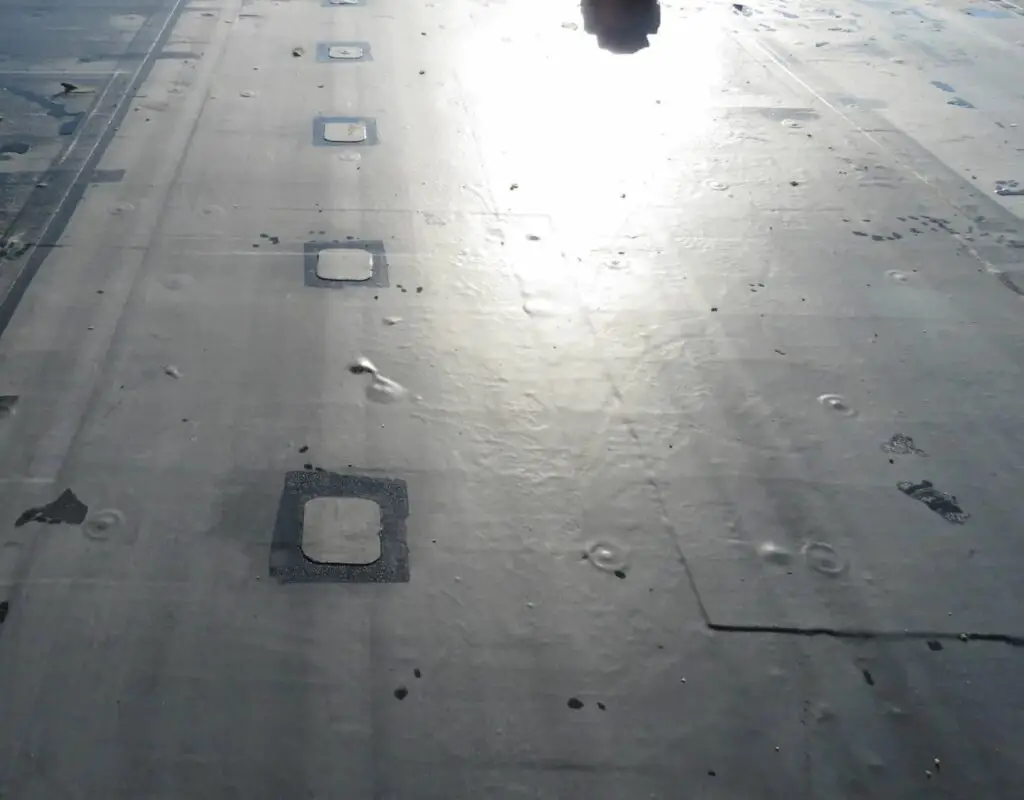
History of EPDM Roofing
EPDM was developed in the 1950’s and first used as a roofing membrane in the early 1960’s. By the 1980’s, it dominated the single-ply roofing market. It’s very common to find an older rubber roof still in place on a building today; when properly installed and well-maintained, these roofs have been known to last for over 40 years. Early EPDM systems relied on liquid adhesives for seams and flashing; the later move to butyl seam tapes and improved primers increased seam durability and installation consistency, which is one reason so many older EPDM roofs are still performing.
Currently, EPDM is used in about 20% of all low-slope (“flat”) roof installations in North America each year, including both new construction and roof replacements. TPO has become the leader over the last two decades, and PVC is also significant, but EPDM remains a popular material due to its flexibility, longevity, cold-weather performance, and repairability.
Geography of EPDM Roofing
EPDM is far more common in the north than in the south these days. Cheaper reflective white membranes such as TPO have largely replaced EPDM in warmer climates due to changing energy code and LEED requirements. In jurisdictions with cool-roof mandates or utility incentives aimed at high solar reflectance, white membranes often win on compliance and energy modeling, which shifts specifications away from black EPDM in hot climates.
In addition, while a fully-cured EPDM field membrane can bake in the sun for 40 years without much degradation at all, the uncured or semi-cured EPDM roofing material used for roof flashings tends to deteriorate much faster under intense UV radiation. EPDM flashings normally fail sooner in Texas than they do in Chicago, for example. A protective coating may be a good idea for exposed, south-facing flashings.
Types of EPDM Roof Systems
Single-ply roof systems are normally referred to by the way the system is attached to the building: there are ballasted systems, fully-adhered systems, and mechanically-attached systems.
Ballasted EPDM Rubber Roofing System
Ballasted EPDM roof systems do not use fasteners or adhesives to attach the roof system to the roof deck.
Ballasted systems use the weight of the ballast (river-washed stone or concrete pavers) to hold the roof system in place. The insulation and the roof membrane are loose-laid over the roof deck, and the ballast is installed on top of the EPDM membrane. Typical roof ballast will be river-washed stone (no sharp edges) in the No. 2 to No. 3 size range, typically at a rate of 10 to 20 pounds per square foot in the field with a heavier application of stone or additional pavers at perimeters and corners. Because they add significant dead load to the structure, the roof deck must be checked for weight capacity, snow load combinations, and seismic considerations.
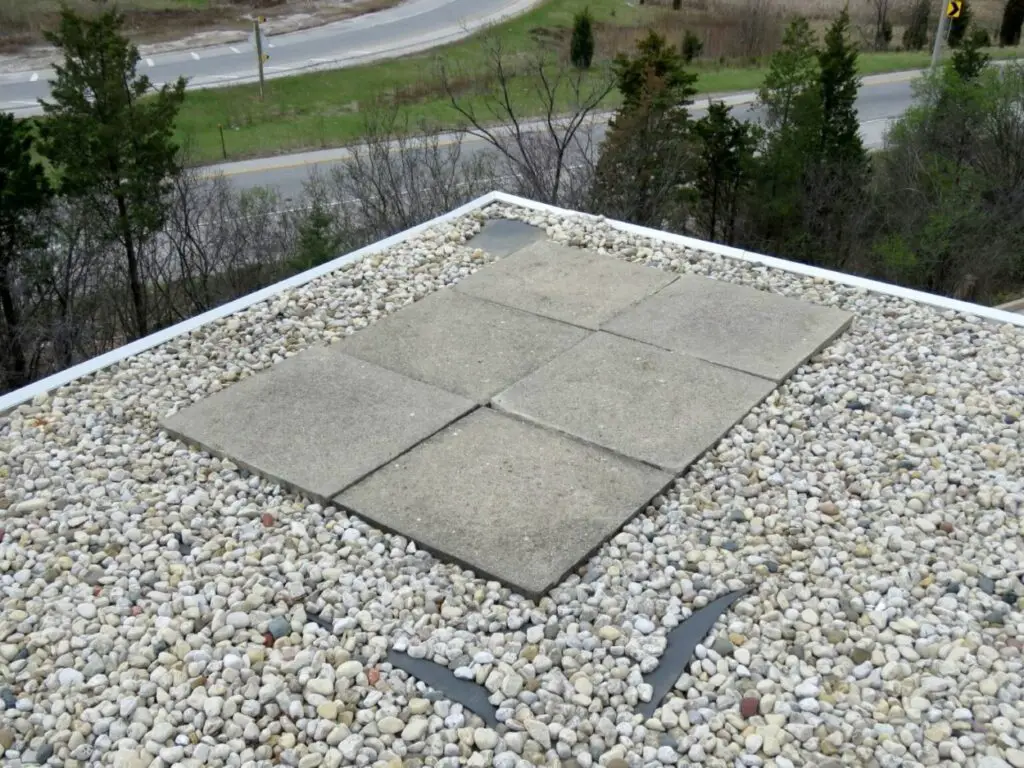
Ballasted systems do not normally include the hard insulation cover board that the other systems use to provide impact resistance. The ballast itself provides the impact resistance. A slip sheet is often installed between membrane and ballast to reduce abrasion.
Because the ballast sits on top of the membrane without the hard support of a cover board underneath it, ballasted EPDM roofing is more susceptible to punctures due to foot traffic than the other systems. The stone tends to deteriorate over time and develop sharp edges, which careless footsteps can push down into the soft insulation and puncture the membrane. Designated walkways with proper walkpads can reduce damage.
This short video from Carlisle SynTec will help you visualize how a ballasted EPDM roof is put together:
Fully-adhered EPDM Rubber Roofing System
Fully-adhered EPDM roofing systems use adhesive to attach the entire roof membrane to the underlying insulation or insulation cover board. The insulation and cover board are typically fastened to the metal roof deck below with specialized roofing screws. This system is called “fully-adhered” instead of simply “adhered” because all EPDM roof systems typically use some adhesive (at the field seams and at perimeter and penetration flashings). Fully-adhered systems are preferred in higher wind zones.
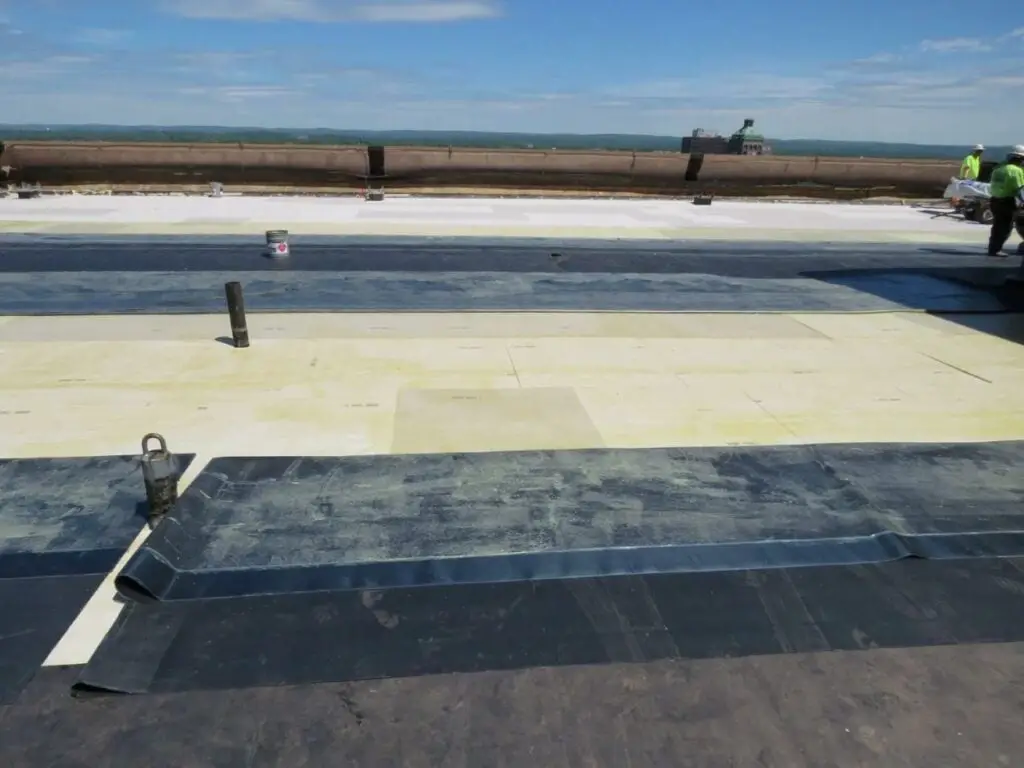
If the roof deck is structural concrete, adhesive may be used to hold all of layers of the roof system in place, instead of fasteners. Concrete decks may also be prepped with a primer and/or a vapor barrier to address moisture drive and improve adhesion.
This Carlisle video gives you a very detailed look at the process of installing a fully-adhered EPDM roof:
Mechanically-attached EPDM Rubber Roofing System
Mechanically-attached EPDM roofing systems typically use long plastic or metal batten strips to hold the field membrane in place. These battens are placed across the roof, on top of the EPDM membrane, usually at the edges of the individual sheets of EPDM that make up the field membrane.
The battens come with holes for fasteners (long, heavy screws) pre-drilled in them, and once they are set in place, fasteners are screwed through them, down through the roof system and into the roof deck. Fastener spacing is determined by wind zone. Proper fastener pull-out values for the specific deck type are required; mechanical attachment is not suitable for every deck without testing.
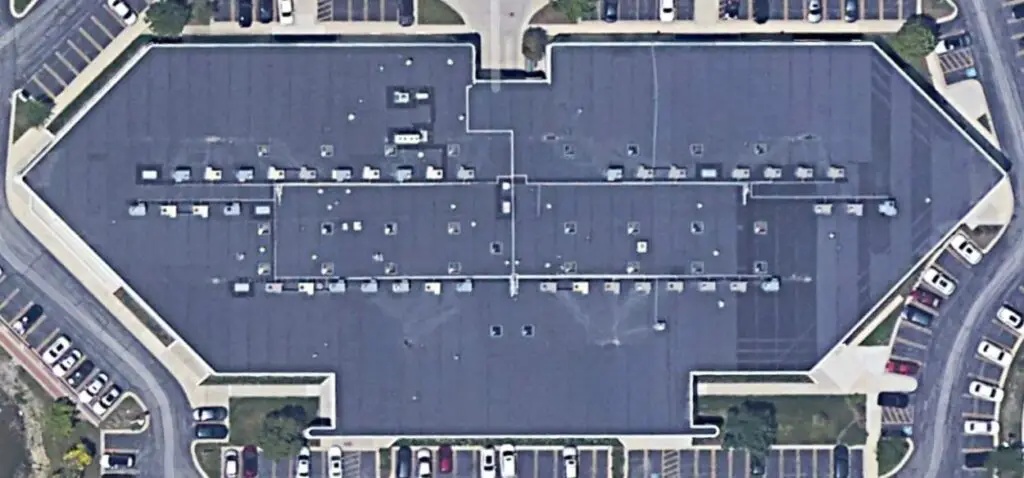
The battens are covered when the seam between the two sheets is completed, the batten securing the edge of one sheet covered by the seam edge of the EPDM sheet next to it. Mechanically-attached systems can billow in the wind; including a continuous air barrier in the roof system can improve performance. Some mechanically-fastened EPDM roofs don’t use battens, and will simply have the fasteners installed with fastener plates in the manner described above, minus the battens.
Noise transmission during high winds and slightly higher heat loss through the fasteners are common drawbacks compared to fully adhered systems.
Here’s another short video from Carlisle that shows how a mechanically-attached EPDM roof is constructed:
Reinforced EPDM vs Non-Reinforced EPDM
Most EPDM roofs in place today use unreinforced sheets, but membranes manufactured with a polyester reinforcing scrim are also used where recommended or required, particularly in mechanically-attached systems. Reinforcement increases dimensional stability and tear strength, which helps with wind-uplift resistance and fastener-line stresses; puncture resistance depends on both thickness and substrate support, so a thicker unreinforced sheet over a cover board may outperform a thinner reinforced sheet in some scenarios.
Flashings on reinforced membrane systems are typically unreinforced uncured or semi-cured EPDM, as reinforced membrane does not conform well to angle changes. Reinforced sheets are typically used for the field membrane only.
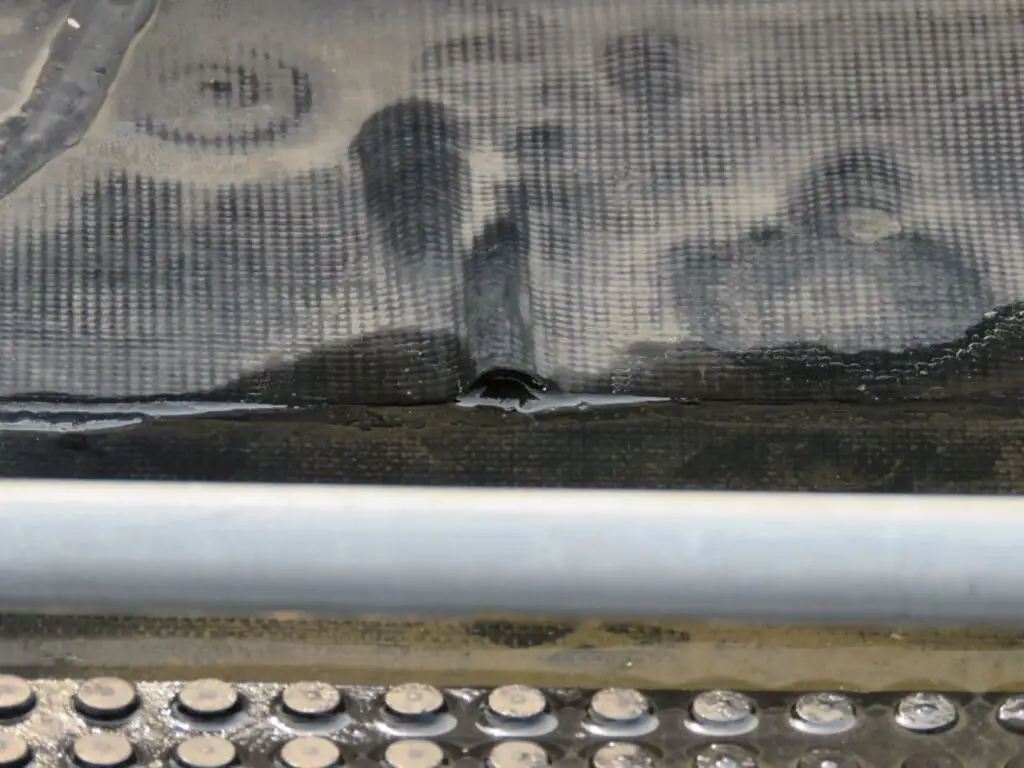
Size of the EPDM Membrane Sheets
Individual sheets of EPDM rubber come in a variety of widths and lengths, with 10 ft. x 100 ft. being a typical size for large roof installations. Manufacturers offer multiple standard widths, commonly from about 5 ft. up to 50 ft. wide, and roll lengths up to 200 ft. depending on the product line and shipping comstraints; larger sheets mean fewer seams but they are heavy, require careful handling, and may need a crane to bring them to the roof.
Much smaller pieces intended for use as membrane patches or for smaller residential flat roofs are easy to find on Amazon. (If your roof is under warranty, it’s important to have a manufacturer-approved roofer make the repairs so you don’t void the warranty.)
Standard membrane thicknesses are 45-mil (0.045 inches or 1.14 mm), 60-mil, and 90-mil for unreinforced EPDM, and 45-mil, 60-mil, and 75-mil for EPDM reinforced with polyester scrim. (Approximate metric equivalents: 60-mil = 1.52 mm, 75-mil = 1.90 mm, 90-mil = 2.29 mm.) Thicker membranes generally improve puncture and hail resistance, while reinforced sheets add dimensional stability and higher tear strength at a given thickness.
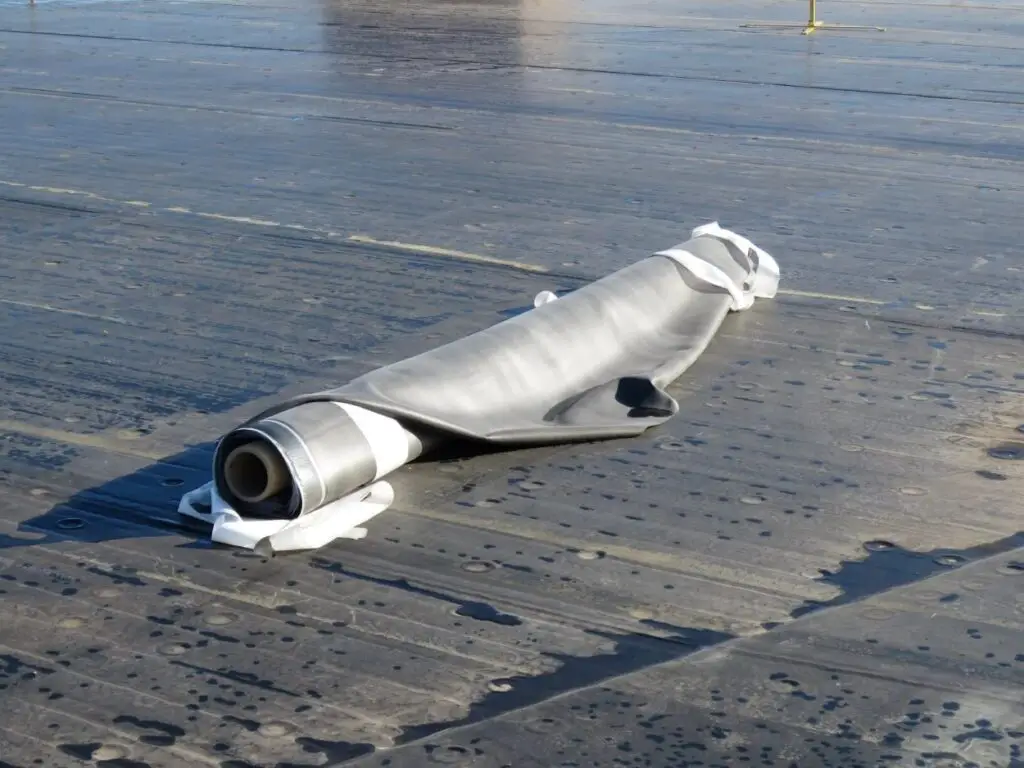
Parts of an EPDM Roof System
Common components in this type of roof assembly are: the roof deck, an air or vapor barrier (if needed), one or more layers of insulation, a cover board (if needed), and the membrane itself, along with attachment components such as adhesives, fasteners, or ballast. Accessories for perimeter and penetration details include edge metal, termination bar, and flashing materials. Air barriers control air movement through the assembly, while vapor barriers control moisture diffusion; some projects require both, some require neither, depending on climate, interior humidity, and deck type.
The field membrane (the vast majority of the surface of the roof) is formed from large sheets (typically 10 feet by 100 feet) of fully-cured EPDM rubber, seamed together with adhesives or adhesive tape during the roof installation. Seams today are usually made using primer and butyl-based seam tape.
Smaller pieces of fully-cured or semi-cured material are used to form the flashings at the perimeter of the roof and at HVAC curbs and other penetrations through the roof. Uncured material is sometimes used on the corners of curbs or other locations with sharp angles.
A cover board, often gypsum or high-density polyiso, is frequently installed over the insulation to improve impact resistance, and tapered insulation or crickets are used to promote positive drainage to internal drains or scuppers. Walkway pads are typically added along service routes to protect the membrane from foot traffic.
Chemical Composition of EPDM Rubber
EPDM is a synthetic rubber, ethylene propylene diene monomer (also called “ethylene propylene diene terpolymer” because it’s a polymer made from three monomers). The rubber used in roofing contains roughly 40% actual EPDM (EPDM base resin). In roofing compounds the diene is most commonly ethylidene norbornene (ENB), and the polymer’s saturated backbone is what gives EPDM its excellent ozone and UV resistance. Actual base polymer percentage varies by manufacturer, sheet thickness, and whether the sheet is cured or uncured. The field membrane is “fully-cured”; it is vulcanized to achieve its long-term properties.
The other ingredients typically include carbon black (around 25%), plasticizing and extending oils (around 20%), with the remainder being various additives including anti-oxidants, anti-ozonants, fire retardants, curing agents, and inert fillers. Carbon black is the primary UV screen and reinforces the rubber; the extending oils are usually paraffinic or naphthenic; common inert fillers include calcium carbonate and clay; curing is typically sulfur- or peroxide-accelerated; fire-retardant packages in roofing EPDM are generally non-halogenated (for example, using aluminum trihydrate). Exact percentages are formulation-dependent, but these ranges are representative of roofing-grade EPDM.
Characteristics of EPDM Membranes
EPDM is an elastomeric, thermoset, black or white synthetic rubber noted for its durability. It has good resistance to moisture, UV rays, heat, hail, ozone, and alkalis and acids. It has a high tensile strength, resists tearing, and remains flexible in cold weather (down to -45°F/-43°C). In roofing applications these properties are verified by ASTM standards for EPDM sheet, and performance is strongly influenced by membrane thickness, reinforcement, and installation quality.
EPDM Color: Black
Sheets of EPDM are black because carbon black is added to them during the manufacturing process. As a raw material, carbon black is an extremely fine black powder, almost pure carbon, which is refined from petroleum or coal. It makes up about a quarter of the final product.
The addition of carbon black strengthens the EPDM resin, reinforcing its molecular structure and increasing its tensile strength. It also protects the polymeric chemical bonds of the material by blocking harmful UV rays, which is a critical function, and largely responsible for the excellent lifespan of rubber field membranes. Carbon black also helps the sheet dissipate heat and resist weathering, which is why black EPDM typically outlasts white EPDM in similar service conditions.
Because almost all EPDM roofs are black, they rarely qualify as “cool roofing” unless coated with a reflective roof coating. The black membrane absorbs almost all of the heat from the sun’s rays during the day, and these roofs can reach temperatures of over 180 degrees on a hot afternoon. In warmer areas where cooling degree days outnumber heating degree days, black EPDM has generally been replaced as a single-ply roofing material by white PVC and TPO.
On the other hand, in colder climates where heating degree days outnumber cooling degree days, a black roof membrane can actually reduce annual energy costs versus white roofing membranes. Energy modeling should consider insulation levels, building use, and utility rates, since membrane color is only one part of total energy performance.
EPDM Color: White
White EPDM is also available and can be used where a cool roof is called for.
White EPDM is formulated with a white pigment, typically titanium dioxide, in place of carbon black. Titanium dioxide is less UV resistant than carbon black, and as a result the white version of this roofing material tends to be somewhat less durable than the black. White EPDM membranes are often formed by laminating a white EPDM top layer to a regular black EPDM bottom layer.
White EPDM roofs are uncommon; it’s more expensive than other white roofing materials and their share of the cool roof market is dwarfed by that of PVC and especially TPO. White EPDM is also more expensive than the regular black material. For a good article on white EPDM, see here.
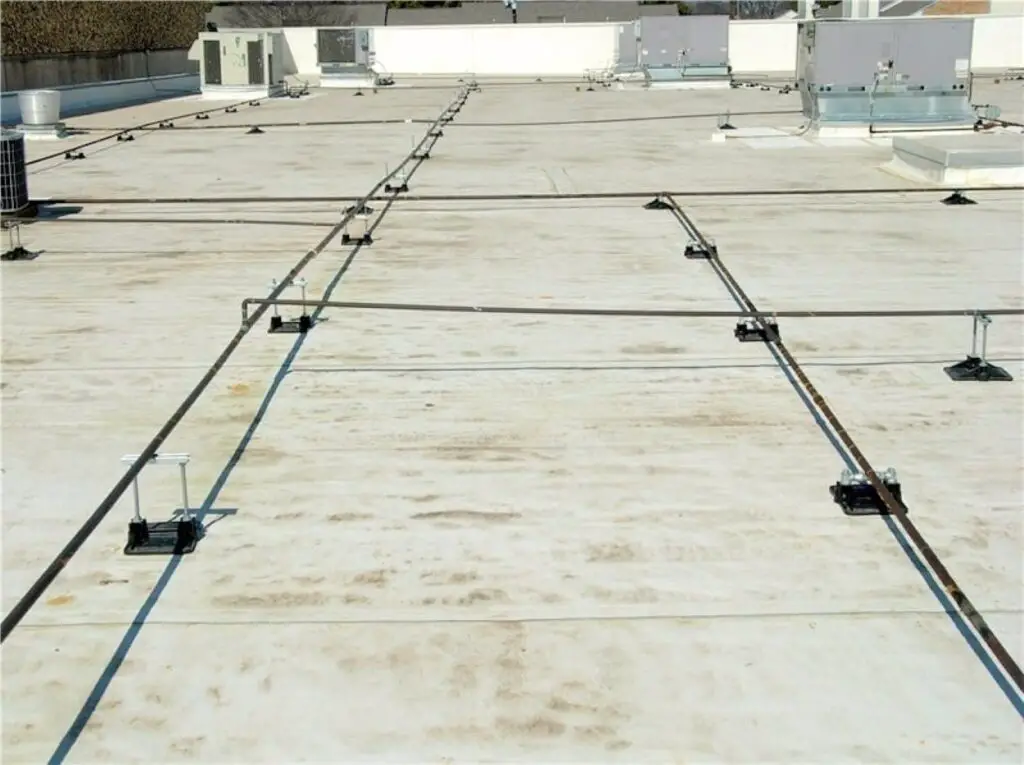
EPDM is Elastomeric
“Elastomeric” refers to the ability of a material to stretch and return to its original dimensions without being damaged. When new, the unreinforced roofing material normally used in ballasted or fully-adhered systems can typically stretch more than three times (300%) its original size without breaking, although this may be reduced somewhat as the membrane ages. Actual elongation-at-break values for EPDM commonly exceed 300% per material specifications.
The reinforced EPDM normally used in mechanically-attached systems is constrained by the reinforcing polyester scrim, which reduces the elasticity of the roof membrane as a whole, and can only stretch about 35% before breaking. This lower elongation is expected, since the scrim is designed to add dimensional stability and tear strength.
For comparison, PVC roof membranes (always reinforced) can only stretch about 15% before breaking, TPO membranes (always reinforced) 27%, and an asphalt built-up roof about 2%.
EPDM is a Thermoset Material
“Thermoset” means that after the polymer chains are cross-linked using heat and chemical curing agents during the manufacturing process, new molecular cross-links cannot be formed. The material is now heat-stable and any future application of heat will either have no effect on it or will simply damage it (at very high temperatures).
In other words, after it’s manufactured, you can’t use a hot air welder on it. This is why adhesives or adhesive tape are required to join pieces of EPDM roofing together. (Thermoplastic roof membranes such as PVC or TPO, on the other hand, are always able to be welded or otherwise altered using very hot air.)
Cured and Uncured EPDM
The completely chemically cross-linked material used as a field membrane is also called “fully cured EPDM“.
Semi-cured and uncured EPDM roofing products are often used as a flashing material where the roof makes an angle change at walls, curbs, or roof penetrations such as vent stacks. These forms of the material are manufactured by not allowing the EPDM polymer chains to become fully cross-linked. This allows those materials to more easily conform to angles after installation without them trying to snap back into a flat sheet shape like the fully cured EPDM roofing product does.
It also means that these materials are more vulnerable to UV radiation and heat, and they will deteriorate faster than the rest of the roof. Deteriorated flashings are a common culprit when it comes to roof leaks in older roofs, particularly the corner patches at curbed HVAC units. Regular inspection of flashings and timely repair of aged corner patches can help reduce leak calls late in the roof’s life.
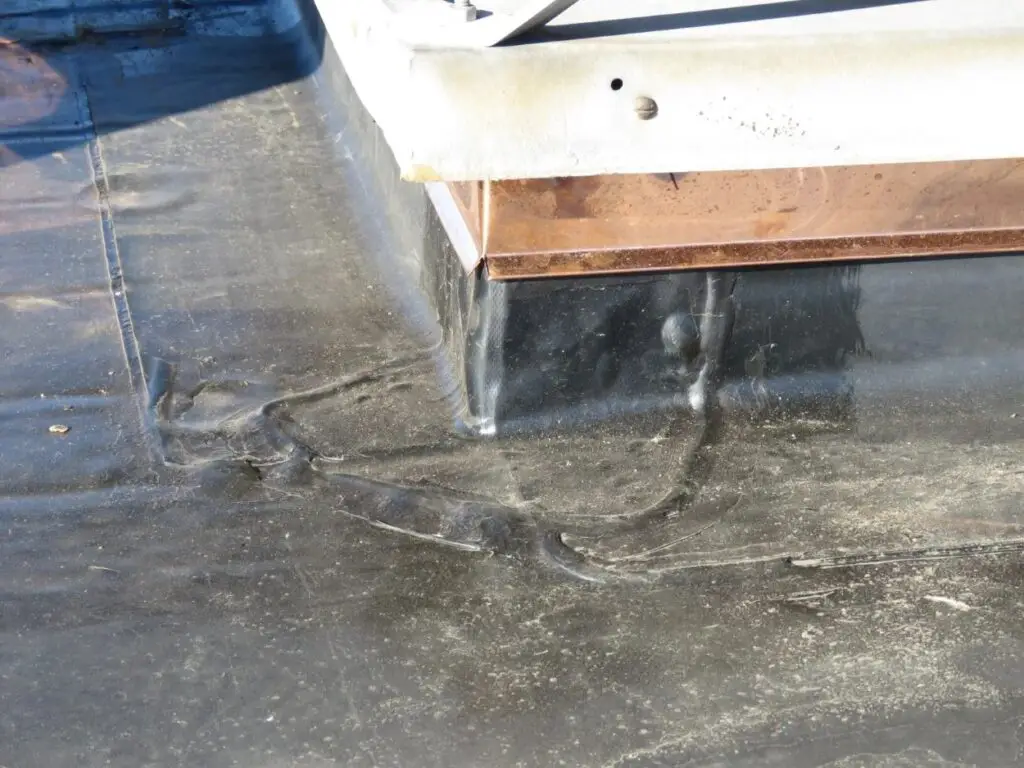
Durability
Fully-cured EPDM is one of the most durable low-slope roofing materials available. Due to its molecular stability, its exceptional resistance to UV radiation, and its non-reactivity in the presence of corrosive environmental substances such as water, acids, and ozone, the sheets that make up a roof’s field membrane can remain functional for over 50 years.
When a rubber roof reaches the end of its service life, it’s almost always due to the failure of the adhesive in the seams or a part of the roof system other than the field membrane material, which tends to be the last thing to go. Common end-of-life drivers include long-term ponding at seams and edges, aged flashing accessories, and mechanical damage at high-traffic areas; eventual chronic water infiltration due to damage and deterioration often leads to the deterioration of the insulation and fasteners.
Lifespans of EPDM Rubber Roof Systems
If an EPDM rubber roof has been installed correctly, with high-quality workmanship and high-quality materials, the key determining factor in the length of the expected useful service life of the roof will be the thickness of the membrane material. The second most relevant factor is the method of attachment. Other factors include drainage quality, UV exposure by climate, foot traffic management, and the consistency of maintenance and repairs over time.
Ceteris paribus, the thicker the EPDM roofing membrane, the longer the system will last.
Fully-adhered membranes generally last longer than mechanically-attached membranes, which generally last longer than ballasted membranes. Fully-adhered systems minimize membrane shrinkage and fastener-line stresses; mechanically-attached systems can see fatigue at seams and fastener rows in high-wind zones; ballasted systems protect the sheet from UV but allow full-roof membrane shrinkage and introduce stone abrasion and added weight that complicates maintenance and leak repair.
The longest lasting type of EPDM roofing will normally be a 90-mil fully-adhered roof, which will typically last around 35 years. Well-designed roofs with excellent drainage and regular, professional maintenance can significantly exceed that mark. But generally, 30 to 40 years of useful service is a reasonable planning range for a 90-mil fully-adhered system.
The type with the shortest lifespan will normally be a 45-mil ballasted roof, which will typically last around 15 years. Where drainage is good, the stone is high quality, and foot traffic is controlled, 45-mil ballasted roofs may last up to 18 – 23 years.
See my chart showing the life expectancies of all kinds of roofing systems for a more detailed breakdown of the lifespans of the different systems, as well as the lengths of typical warranties.
These are general guidelines and any kind of roof can fail much earlier than its design lifespan if it is poorly maintained, subjected to damaging chemicals or careless foot traffic, improper alterations, or extreme weather events beyond what the roof is designed to handle.
Things That Damage EPDM Rubber Roof Membranes
Rubber roof membranes are easily damaged by sharp objects, oils, gasoline and other fuels, grease, fats, and solvent-based asphalt compounds such as asphalt roof cement. See this chart for a long list of chemicals and whether you can expect them to damage EPDM. A good rule: if a product is petroleum-based or solvent-borne, keep it off the membrane and clean any spills immediately.
Sharp Objects
EPDM rubber roof membranes, especially unreinforced membranes, are fairly easy to puncture. (Walkway pads along service routes and thicker membranes help a lot, and the use of a proper cover board under the membrane will improve puncture resistance.)
Dropped tools, nails or screws which are spilled on the roof and then stepped on, and even sharp stones caught in the tread of a boot have all been known to make holes. This is a common source of roof leaks with this type of roof. Require thorough cleanups as part of your roof access rules for tradesmen and require magnetic sweeps after work on the roof where screws or nails are used.
Special care should be taken when walking on older ballasted EPDM roofing systems, as the ballast stone tends to crack and split over time due to thermal cycling. There are usually a large number of jagged stones all over a ballasted roof that you want to avoid stepping on with too much force. Tread lightly!
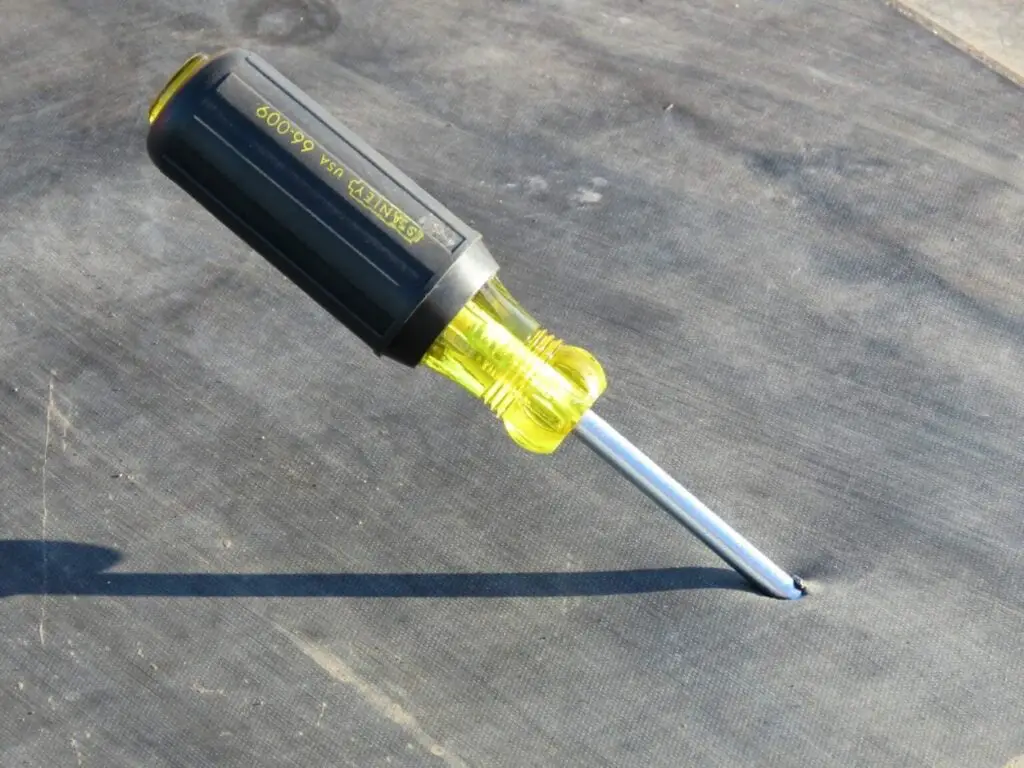
Fasteners Backing Out
Fully-adhered EPDM systems may be damaged if the fasteners that secure the cover board and insulation underneath the membrane become loose and start working their way back out of their holes. This can be the result of poor installation, corrosion of the deck or the fasteners themselves, or water damage to the cover board or insulation due to roof leaks. You will often see this as small bumps or “pimples” telegraphing through the sheet.
These fasteners can back out and up, puncturing the membrane from below. Luckily, this is an easy issue to spot during a maintenance inspection. Temporary repairs can be made by simply applying a thick patch over the problem location to prevent leaks. If the issue is widespread, there is a risk of catastrophic roof failure due to attachment failure, so you will want to bring in a roof consultant to determine the best course of action. If the roof system is still under warranty, contact the manufacturer’s warranty department. If wet insulation is present, remove and replace the wet area before patching or the problem will return.
A proper repair would be to cut the membrane around the area, pull out and replace the fastener, and patch the area. If wet insulation is present, remove and replace the wet area before patching or the problem will return.
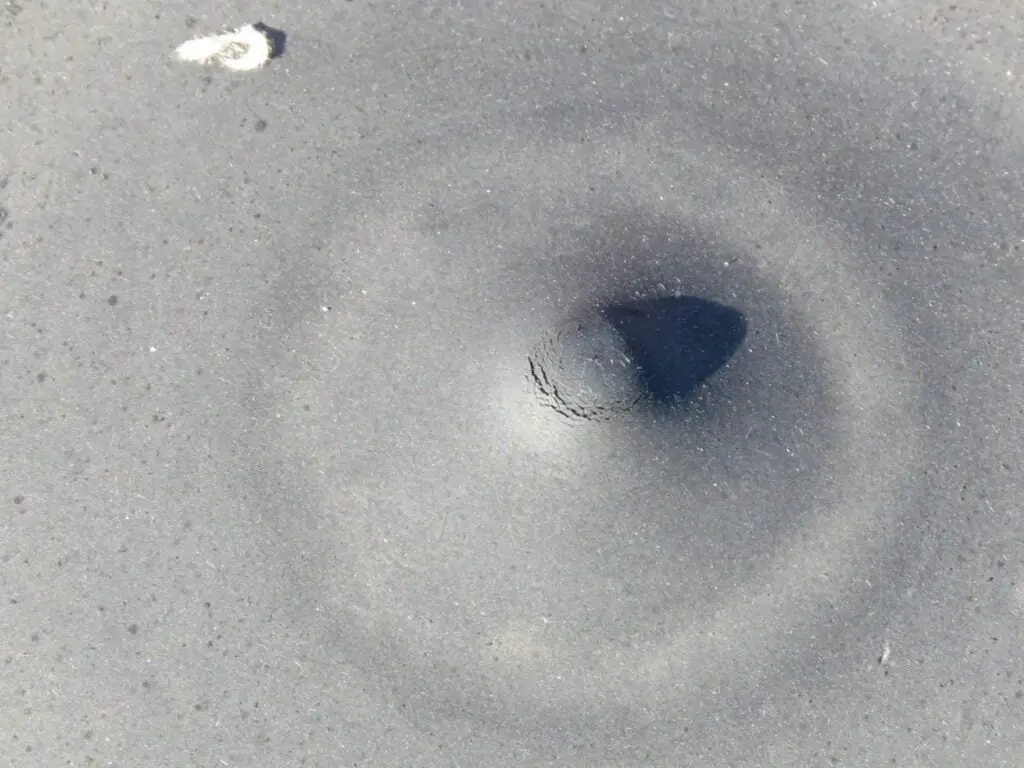
Use of Asphalt with EPDM
EPDM roofing is not generally compatible with asphalt, although temporary contact with pure asphalt or polymer-modified asphalt is not something to worry about. However, EPDM is completely incompatible with solvent-based asphaltic roofing materials such as roofing cement or roofing mastic.
These materials combine petroleum-derived solvents with asphalt to produce a workable, plastic asphalt that can be spread with a trowel or applied with a caulking gun. The solvents in these products will quickly damage EPDM roofing membranes. Aromatic and chlorinated solvents are particularly aggressive and can cause swelling, softening, and loss of tensile strength in EPDM.
Although EPDM can tolerate some forms of asphalt quite well in some cases, to be safe you should never use an asphalt-based product on an EPDM roof. When in doubt, check the manufacturer’s chemical-compatibility chart before using any sealant or mastic near EPDM.
Other Petroleum Products
Occasionally, other trades (we’re looking at you, HVAC mechanics) will spill petroleum-based fluids on a roof and fail to immediately and completely clean it up. Typical culprits include lubricants, cutting oils, kerosene, diesel, and solvent cleaners.
Within weeks a contaminated EPDM roofing membrane will wrinkle and start to break down; the material at the location of the spill will grow thinner and weaker, and eventually small holes will appear. Spills should be immediately blotted, wiped up, and then washed with the manufacturer-approved cleaner, and the affected area should be cut out and replaced if swelling or softening persists.
It’s a good idea to check the area where anyone has been working up on your roof as soon as they finish, in case you need to have them do a better job cleaning up. Make post-work inspections part of your roof access policy.
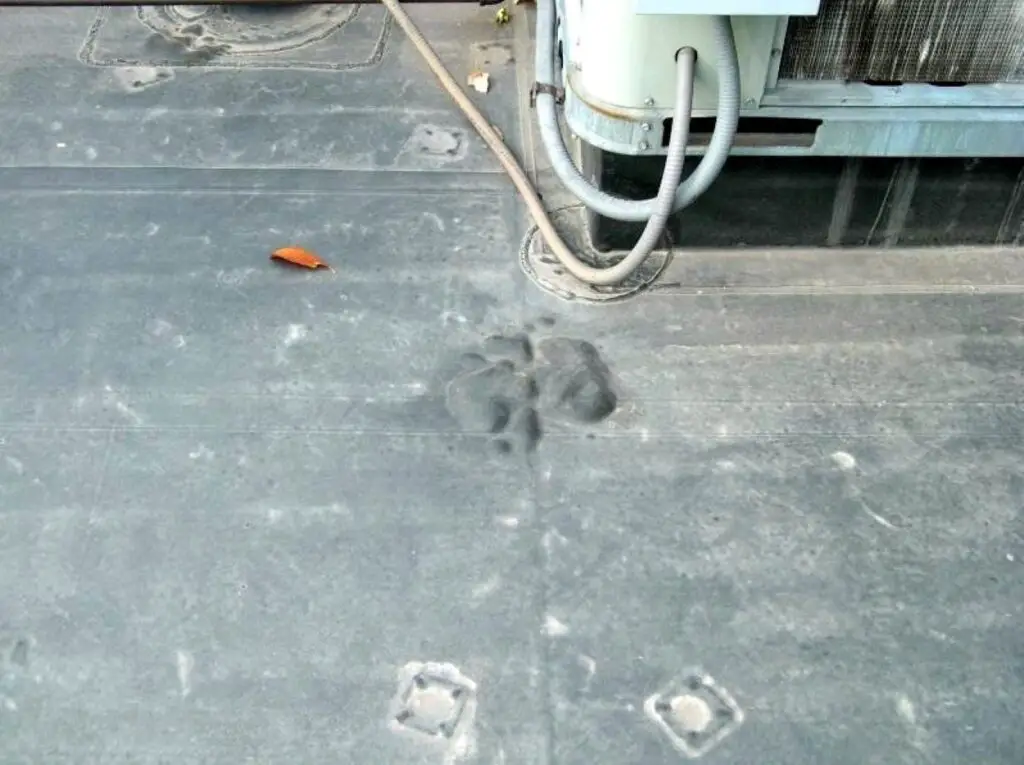
Restaurant Kitchen Grease
A major concern with EPDM roofing is restaurant kitchen exhaust. It’s very common to see severe roof damage around kitchen exhaust fans as kitchen grease accumulates on the surface of the roof. Kitchen grease affects EPDM roofing much the same way that petroleum products do. Grease and animal fats migrate into the rubber and destroy its physical properties.
Damage to the roof can be prevented by installing a protective layer of a more grease-resistant roofing material (sheets of PVC roof membrane work well) around the exhaust location. This must be coupled with a good rooftop grease containment system. Both should be sized for the specific exhaust rate and maintained on a regular schedule, with absorbent media replaced before saturation.
Both of these things should be professionally installed, and they must be installed before the damage starts. EPDM roofing already damaged by grease will have to be removed and replaced. It should not be left in place and simply covered up by a patch, as the patch may also become contaminated. If contamination is localized, cut out and replace the affected membrane and any damaged substrate, then extend the protection zone farther beyond the exhaust footprint.
Property managers should keep a close eye on their restaurant tenants. Restaurants seem to remodel their spaces more often than the average tenant, and they tend to make more unauthorized roof penetrations. Require roof work permits for tenant build-outs and verify that any new roof penetration work is performed by a qualified roofer approved by the roof system manufacturer.
If a new tenant is opening a restaurant, whether or not the space has been used as a restaurant before, that is a particularly good time to inspect the roof. Have someone check to make sure they aren’t making unauthorized roof penetrations. Make certain that they’ve installed adequate protection for the roof around the new kitchen exhaust vents. Add this inspection to your pre-opening checklist, and document conditions with photos so you have a baseline for comparison if there are roof issues in the future.
